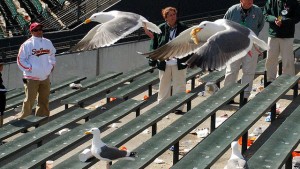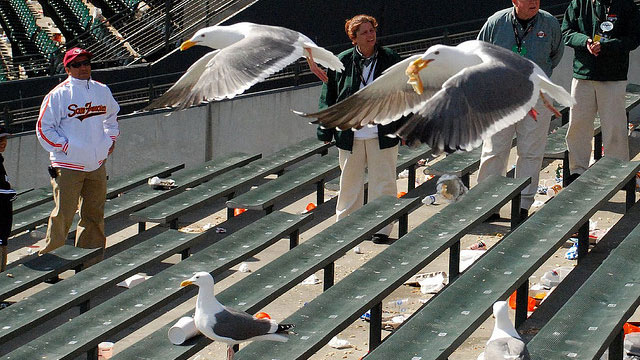Dan Murphy, Volunteer with Golden Gate Audubon:
It's a crime of opportunity. They're very well attuned to our behavior and our trash. When there are large numbers of people in the stands, gulls don't come into the ballpark. But they can sense when things are starting to wind down. A lot of people leave the game before it's over, so they might be clued in by people moving out of the upper deck toward the eighth inning. That makes sense since they seem to settle on the left field side first.
If a game goes into extra innings, the gulls still seem to know when the ninth inning is. You'll see them sitting on the roof or on the big glove in the outfield, waiting for the game to end. That may still be due to the fans that leave early, but they seem to have a sense of how long games normally go. It's likely that a few birds are always watching and as soon as a few birds go in, others will follow. They're really good at what they do. They find food sources and use them to the max.
David Shuford, Biologist with PRBO Conservation Science:
Gulls spend their day cruising around a lot. But once they figure something out, they tend to come back. So even though the ninth inning doesn't happen at the same time each day, once a few gulls pick up on it, you'll soon have a crowd. It's possible that they can recognize the sounds, too, like songs that are played during the game. Gulls are pretty good about sound.
In general, they're really good at figuring things out. Like when local dumps are closed on the weekends, the gulls seem to know that and don't show up on those days. It's hard to know if they truly know what Saturday is. They may just be cruising by and not see any action, so they don't land. But they seem to recognize the pattern.
Gulls have an advantage - they're total generalists. They're smart and they're tough. They can eat just about anything too. They go after fish, garbage, and other birds. Some of our work on the Farallon Islands has shown that gulls can actually recognize certain individual people as well.
Josh Ackerman, Research Wildlife Biologist with USGS:
They do exactly that same thing at the landfills in the Bay Area. We've done studies on gulls where we've tagged them with transmitters and tracked them daily for two years. California gulls depend on a few of the landfills in the South Bay for food. They arrive exactly when the dumps open and leave right when they close, since the trash piles are covered up when the landfill isn't operating. From our studies, we know that the gulls cover a lot of territory during the day, so it's not a big deal for them to travel to find food.
George Costa, Senior Vice President of Ballpark Operations at AT&T Park:
We've seen an uptick. There seem to be more gulls lately. They always time their arrival to an inning or two innings before the game ends. They're creatures of habit. They know where the food is and that crowds mean food. They're never here except for game days, but if there's a game, they crash the party every night.
It's a series of triggers that tells them it's time. They see the lights and the crowds. There are food smells, like the garlic fries. It's a combination of all those things. You'll see the gulls line up on the left field roof before the game ends. We see the scouts come in and they cue the rest of the gulls.
It's a nuisance really and the fans don't enjoy it. So we're looking at a variety of possibilities to deal with it, including having a falcon on site. They've used them at other ballparks and they seem to work there. You won't get rid of the gulls completely, but we think it would get rid of about 80 percent. We have to retrain these gulls.

